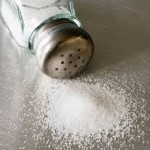
Research shows that six month old infants who have been introduced to salted starchy food have a greater preference to salty taste as compared to infants who are not yet fed such foods. This early exposure to salty food is carried on to preschool with preference to salty food.
In a more recent study, scientists found that children with higher body fat prefer saltier food. Sodium is critical to maintain life. It is estimated that the amount of salt required to maintain normal osmotic pressure and physiologic functions is about 200 mg of sodium per day. But in a typical Western diet the average intake of sodium per day is about twenty times higher.
One frankfurter may contain 600 mg of sodium and consuming a serving of miso soup will add about 1,000 mg to your daily sodium intake.
Salt Facts
- Sodium mg X 2.54 = Salt mg; Divide mg salt by 5,680 = teaspoons.
- 75% of sodium intake is from processed and restaurant food.
- About 26% of adults suffer from hypertension.
- Unlike calcium and other ions, we don’t store sodium in our body.
- Reduction of salt in a high salt food product results in lower preference.
Excess Salt Intake Linked to Chronic Diseases
In the first century AD, The Yellow Emperors Classic of Internal Medicine, a Chinese book, warned that salt (sodium chloride) could cause high blood pressure. But the link of salt intake to health was far from being clear. Some studies even indicate that low salt intake is unhealthy and may lead to dangerously low blood pressure. More recently, the accumulated data from epidemiological studies have clearly shown that excess salt consumption causes adverse health effects including vascular, gastric and kidney diseases. This drove health organizations and the food industry into action.The World Health Organization (WHO) advocates sodium reduction in food to a level of 2,000 mg per day and even further reduction to 1,200 mg for those people with hypertension and cardiovascular risks.
Salty Taste and Sodium Reduction Approaches
“It is amazing that we still don’t know the mechanisms of salty and sour tastes” Dr. Gary Beauchamp, Emeritus Director and President, Monell Chemical Senses Center.What is known is one mechanism. A “receptor” for salt is sodium ion channels on the membrane of some taste cells. The larger the sodium chloride concentration, the larger the polarization in the taste cell and the higher the perception of salty taste. The lack of understanding of the mechanism of salty taste and the absence of a known receptor inhibits the design of salt substitutes or salt enhancers that can be used in reducing sodium in food products.
This didn’t stop the food industry from exploring various approaches to partially reduce salt in food products but still maintain the desired taste profile. These salt reduction methods can be grouped as follows:
- Stepwise stealth reduction: In the last several years the food industry gradually reduced the salt content of food products by 50% in some food categories. This salt reduction initiative didn’t spark consumer complaints.
- Physical modification of salt: Smaller or lower density salt crystals, when applied to potato chips, provide faster dissolution and higher concentrated perception of saltiness.
- Potassium chloride based products: Potassium chloride can generally replace only up to 30% of sodium chloride. This is due to the typical metallic or bitter taste associated with Potassium chloride. Several companies developed ways to overcome these limitations by adding masking agents or by co-crystallization of the two salts and thus are able to reach 50% sodium reduction in some food applications.
- Additives that elicit salt perception: General Mills recently filed a patent teaching the use of certain natural products that were found to be salt modulators, namely, compounds that may be used to reduce the sodium contents in food while imparting a similar level of saltiness. Several other companies are pursuing a similar approach.
We have made progress on the fat and sugar fronts while salt and sodium reduction is still a challenge. Progress in deeper understanding of salt taste mechanism will enable progress on the salt front as well.



Comments